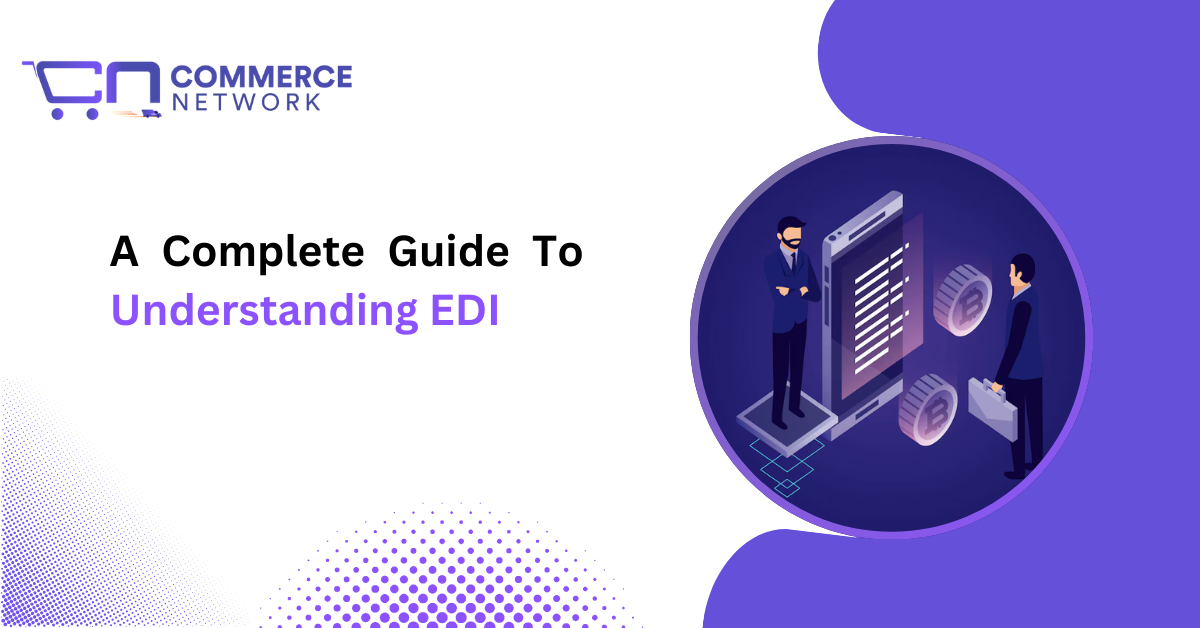
EDI is used today in most B2B transactions. Many businesses large and small use EDI for document exchange, financial transactions, government contracting, and more.
But what exactly is EDI? How did it come to be? How does it work? What documents does it exchange? What are its standards? How does anyone implement EDI in their system?
This guide provides a complete overview of EDI whether you are a seasoned expert or a beginner trying to get EDI integrated into your business.
EDI is an abbreviated form of Electronic Data Interchange whereby data is sent and received electronically between two businesses rather than paper-based methods like post mail or fax.
In simple terms, EDI means electronically passing documents used in businesses between two computer systems in a standard format recognized by both systems.
Businesses need to exchange documents (like purchase orders, invoices, shipping notices, etc.) between parties connected in their partner networks.
Manually creating, transmitting, and uploading the document data in the software systems is a time-consuming, error-inducing, and costly process. EDI solves this problem by allowing the automatic transfer of business documents easily and efficiently.
The seeds of EDI began during the Cold War in the late 1940s, when the Soviets blocked the Allied powers the chance to transport thousands of tons of cargo to West Germany. So, a US Army Master Sergeant Edward Guilber developed an electronic system to track cargo shipments through the air to bypass the blockade.
EDI works by mapping and translating a document from its original format into an EDI standard format, then sending it through a secure pathway where the receiver will receive and reverse-map the EDI-translated document into a format readable by humans and internal business systems.
There are three major components of EDI.
Standards, or EDI standards refer to the predefined set of rules defining the structure and format of how an EDI document is created, and processed so that all parties involved in the transaction can understand and interpret the data on EDI documents. E.g. ANSI X12 and EDIFACT
EDI formats means how an EDI document is structured based on the guidelines of the EDI standards. Every EDI document must use a specific file format and include data elements in that format. E.g, EDI 850, EDI 810, etc.
Protocols define how an EDI document is sent and received between two computer systems. They also define the encryption used in securing the EDI document during exchange, the hardware and software system processes used to create, store, transmit, and interpret EDI data, and provide guidelines on the overall transmission process. E.g., FTP, HTTP, etc.
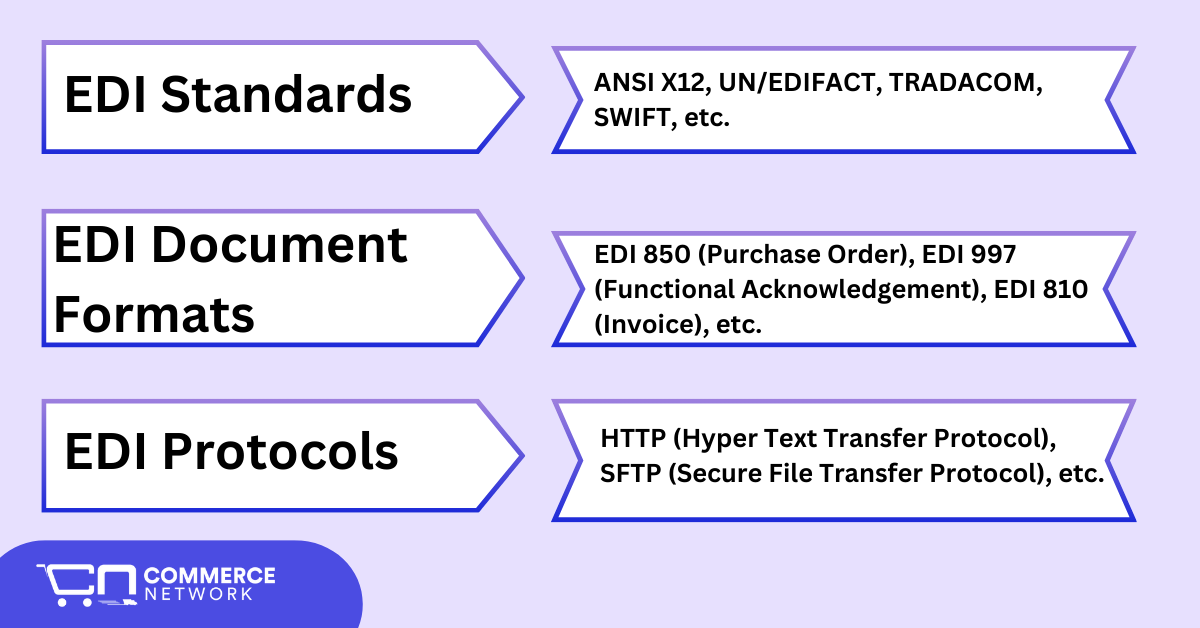
EDI document exchange process is an electronic and automatic process that takes between two computer systems of a sender and receiver.
Here is a step-by-step process for exchanging EDI documents between a buyer and a supplier for document transfer who have EDI integrated into their internal business systems.
Throughout the exchange, there is no need for any manual intervention as all the processes happen automatically and electronically between the internal systems of the businesses and the integrated EDI solution.
Learn how EDI Order Automation Works
As EDI became more and more popular, different countries, organizations, industries, and trading partner networks started sending and receiving electronic documents to their preferred methods.
This created problems during the onboarding of a new partner that used a different EDI document method, a business from a different industry using a different standard, or during cross-border transactions.
So, a unified EDI standard for EDI documents soon became necessary.
In response, several standards were established that were to be followed by all businesses doing transactions using EDI.
Here are some of the most common EDI document standards.
This is the most popular EDI standard used today mostly in the United States and North America.
The ANSI X12 standard was developed by the American National Standards Institute (ANSI) through its subsidiary called the Accredited Standards Committee (ASC) in 1979 to facilitate electronic document exchange among different industries in North America.
The X12 standard uses 3-character numeric codes to represent different different EDI document types.
Example: The EDI document of a Purchase Order (P.O) is represented with the code 850 in ANSI X12 standard.
ANSI X12 standard encompasses a broad spectrum of industries and is used in most US EDI document transactions across healthcare, retail, transportation and logistics, finance, and more.
In 1996, HIPPA (Health Insurance Portability and Accountability Act) was enacted which mandates the use of the X12 standard on every healthcare EDI document in the US.
EDIFACT stands for Electronic Data Interchange for Administration, Commerce, and Transport.
It is an EDI standard established by the United Nations body called the Centre for Trade Facilitation and Electronic Business in the late 1980s and early 1990s and is often called UN/EDIFACT.
Primarily used in Europe in the supply chain logistics, transportation, retail, and electronics sectors, EDIFACT is another popular EDI document standard used today.
This standard facilitates global trade and electronic data transmission and is used by thousands of industries worldwide making it another popular standard.
Unlike ANSI X12, EDIFACT uses a 6-character alphanumeric code for the identification of EDI documents.
Example: A Purchase Order is represented as ORDERS in the UN/EDIFACT standard.
TRADACOMS is an EDI standard that is mostly used in the United Kingdom. It was established in 1982 and became widely used in the UK retail sector.
TRADACOM is mostly outdated nowadays due to the EDIFACT standard, but it is still popular in the UK retail market as many retailers still use this standard.
The standard is a precursor to the EDIFACT standard, hence it also uses a 6-character alphanumeric code for EDI documents.
Example: An EDI message with the invoice will use the code INVFIL in the TRADACOM standard.
EDI documents are the cornerstone of any EDI transactions. There are different types of EDI documents depending on how and in what environment an EDI transaction is being carried out. For example, sending an invoice is different from requesting items through a purchase order.
So, depending on the transactions, EDI documents are created and transmitted for specific transactions. Here are some common EDI documents.
Some industry-specific EDI documents mostly used in one particular industry include:
EDI comes in different types. Some are on-premise solutions, some use cloud hosting for EDI, some use Web EDI, and some use EDI via a VAN.
However, the two most used EDI solutions include the on-premises EDI and Cloud EDI.
On-premise EDI solutions have been around for a long time since the adoption of EDI began. These solutions require you to integrate EDI into your on-site business infrastructure.
It means getting EDI hardware and compatible software and adding them to your computer systems in your business locations. It also means training your staff on how to operate and maintain the infrastructure.
This is a costly endeavor as you need to spend time and money to get the necessary hardware/software and hire or train staff so that they are capable of maintaining an EDI-capable infrastructure.
With the development of cloud computing, on-premise EDI solutions are slowly but surely getting outdated. A cloud EDI solution offers several advantages making them popular among businesses that have or are trying to get EDI integrated into their system.
With a cloud-based EDI solution, all of the necessary hardware and software, as well as operational and maintenance staff will be provided by an EDI provider that handles your EDI needs.
You can integrate the EDI solution into your business systems like ERP and Accounting systems for smooth and efficient document exchanges.
Once the cloud EDI is integrated into your system, you can access it through a web dashboard to get real-time visibility of your EDI operations.
Cloud-based EDI is easy to adopt and scale if the need arises in the future. Moreover, you also do not need to incur the extra cost of buying hardware/software and training your maintenance staff.
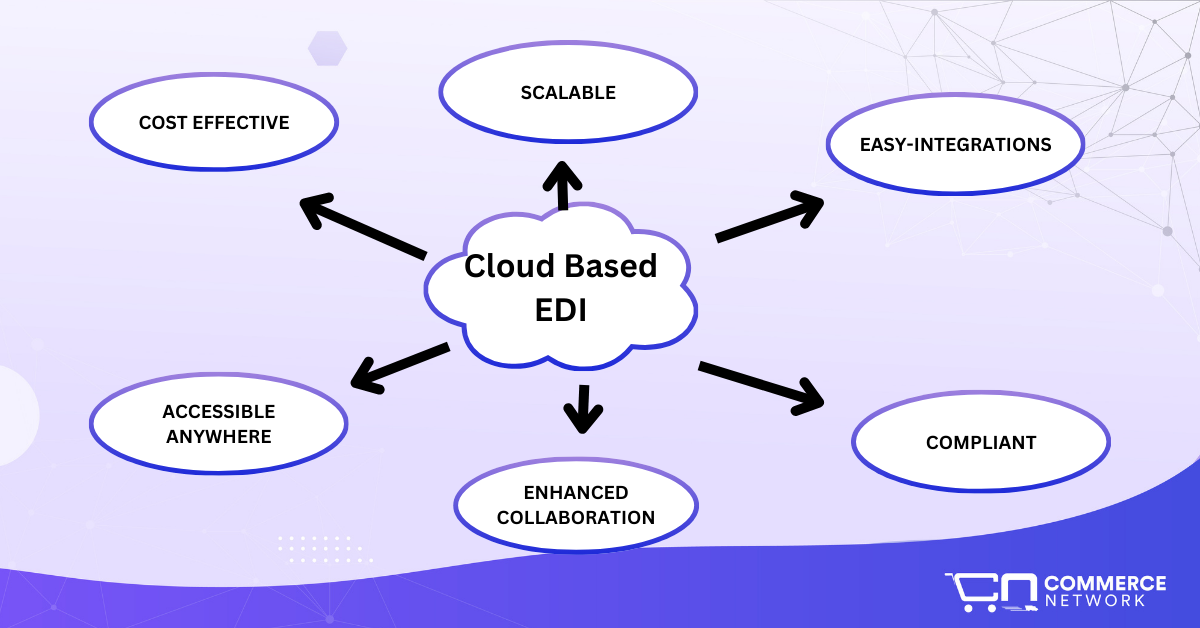
Commerce Network offers a comprehensive Cloud-EDI solution that encompasses all your EDI needs and helps you streamline your supply chain.
Check Commerce Network’s Cloud-based EDI Solution.
Implementing EDI needs is a complex business requiring the use of sophisticated tools and software. These tools play key roles during each process of EDI implementation like translation, mapping, transmission, etc.
Some software tools required for implementing EDI include:
Commerce Network’s all-in-one EDI tool handles these tasks easily so you do not have to spend extra cost and effort securing each of these software separately.
The platform provides seamless translation and mapping with full compliance support among trading partners and government agencies, is a DoD-certified Value Added Network (VAN) for secure data transmissions, and integrates with Netsuite ERP and QuickBooks Accounting systems commonly used by businesses.
It also supports API connections and eCommerce marketplace integrations like Amazon, Walmart, Shopify, and more.
Learn more about our Features.
EDI integration involves the process of integrating an EDI solution into the business’s internal systems. The internal systems of businesses like ERP, WMS, Inventory, and Accounting systems handle administrative, financial, and other related tasks.
Integrating EDI solutions to these business systems streamlines document exchanges as EDI automates the process, reduces manual intervention, and helps increase visibility and error handling, among other things.
EDI Integration With ERP Software: The ERP (Enterprise Resource Planning) software acts as a core business platform managing human resources, financials, supply chain, procurement, sales, and related business activities.
By integrating EDI into a company’s ERP system, the exchange of business documents internally as well as externally becomes automatic, faster, error-free, and standardized. This helps increase overall business efficiency and improve profits.
EDI Integration With CRM Software: The CRM (Customer Relationship Management) software helps a business interact with its customers, discover potential customer opportunities, store customer information, etc.
Integrating EDI with CRM software faster responses to customer inquiries, automates customer information exchange within a business's internal system for quick processing, improves customer satisfaction with enhanced delivery of information, and more.
EDI Integration With WMS Software: The WMS (Warehouse Management System) of a company helps manage warehouse inventories by tallying inventory data, optimizing real-time inventory stock levels, and managing order fulfillment processes.
Integrating EDI with the WMS system helps with order processing, catalog management, inventory level optimizations, and automated supply chain operations.
EDI Integration With Accounting Software: A business’s accounting software is a platform to create, maintain, monitor, optimize, and remove any financial information about its staff, clients, suppliers, and more.
Integrating a company's accounting software with the EDI system allows faster processing of financial data, helps with banking transactions, optimizes compliance management with partner systems, and improves the overall financial situation of the business.
Modern data transmission not only depends on EDI but there is another method of data transmission; the API (Applicable Programming Interface).
API uses endpoints, methods, and data formats to exchange data and information. Although it differs from EDI, APIs are fast becoming very popular data transmission methods among both new and legacy business systems.
Merging EDI and API is a relatively new but very effective approach most business systems have started to adopt in recent times. APIs allow a more dynamic data transmission across diverse formats and real-time exchanges.
Here are some key roles API plays in modern EDI setups.
APIs convert data from EDI standard formats like X12 and EDIFACT into other formats like JSON and XML which are used in point-to-point business communications and modern web application development.
As opposed to batch processing of large amounts of data done in EDI, API allows real-time and instantaneous data exchange. So, combining EDI and API helps exchange a large batch of data as well as perform real-time exchanges of smaller information which most business systems need.
Integrating EDI into many legacy systems as well as modern internal business systems can be complex. API negates this by easily helping integrate with business systems and manage data exchanges in a more modern scenario.
So, why should anyone use EDI? Why not just use emails and APIs to transfer business data? Well, EDI offers some significant advantages for businesses that other modern communications simply cannot offer. Here are some of its benefits:
Using EDI means you do not have to hire a large number of employees to manually input data and information on the business systems. Moreover, EDI automates data processing by automatically syncing with suppliers, clients, and your business’s internal systems and can handle large amounts of data exchanges at once, thereby increasing efficiency.
Imagine you have hundreds of employees manually inputting thousands of data and information every day. Even being careful, there will often be times when errors occur. This can become a big problem especially when batch-processing a large amount of product information, customer details, and financial data.
EDI processes large amounts of data automatically and electronically while providing real-time visibility for any errors that occur during the transmission process. This helps improve accurate data exchanges and reduce errors potentially saving a business millions or billions of dollars in the long run.
Your business network grows well along with EDI adoption. You can establish trading relationships with suppliers, other businesses, government agencies, and major online retailers (Walmart requires the use of EDI for B2B transactions!) by having EDI capabilities.
You will also adhere to all compliance standards through EDI adoption making you more popular among your peers, government agencies, as well as major suppliers and distributors, potentially boosting your profits.
While EDI certainly helps overcome supply chain hurdles and increases efficiency, there are several challenges to adopting an EDI solution.
There are several barriers to adopting EDI. Overcoming these barriers will be the key to having a full-fledged EDI service integrated into your business.
Let us say you overcame hurdles in implementing an EDI solution, there is the issue of ensuring compatibility. This means that your EDI system needs to be compatible with your partner's system.
The mapping of data and specifications, and maintaining ongoing compliance issues with multiple trading partners can be quite a headache for many businesses.
As your business grows, so should your EDI solution. This needs extra time and cost as you need to maintain partner compliance, add additional functionalities in your EDI infrastructure, and identify as well as process any errors that occur during the process.
A popular and efficient way to solve the many problems facing EDI adoption and maintenance is to use a cloud-based EDI provider.
Cloud-based EDI providers are businesses that are solely responsible for creating, integrating, and maintaining an EDI service for their clients which the clients can access from anywhere via the Internet and maintain real-time visibility of their EDI activities through a web dashboard.
You can look for EDI providers and integrate their EDI system into your business, paying them a subscription fee. The service providers will implement and maintain the EDI capabilities you shall need in your business, solving all the problems in the process.
This ensures you do not have to invest extra time and resources in an in-house EDI service, solving a big problem faced by many small as well as large businesses that require EDI solutions.
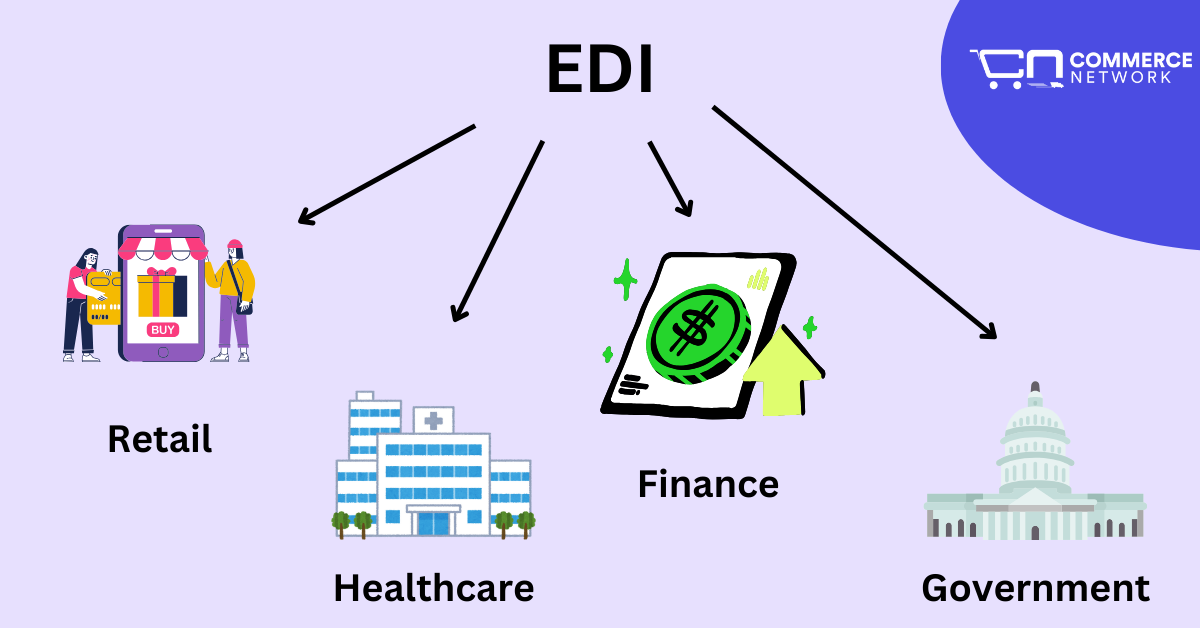
While EDI has been around since the 1960s, with globalization and interconnected supply chains, the fast processing of business documents has become more and more necessary in healthcare, finance, retail, and many other sectors.
Hence, the adoption of EDI has also been rapid. No matter which industry your business caters to, there is a need for EDI implementation.
EDI is used extensively in the retail sector for generating purchase orders, managing inventories, getting shipping details notifications, processing invoices, and communicating with vendors.
Retail is the sector with the most use of EDI among many other industries. Major retailers like Walmart have been adopting EDI since the late 1970s.
With many goods being shipped, and products being ordered from supermarkets and grocery stores to a large number of suppliers, wholesalers, and distributors, EDI has become the most important tool for maintaining communication and document exchange processes.
Healthcare businesses had been using electronic message transfer for a long time before the enactment of the HIPPA Act in 1996. The HIPPA Act mandated the use of EDI and accelerated the adoption of EDI in healthcare.
While the initial focus of healthcare EDI was in insurance claims processing, nowadays, EDI is used in many healthcare fields like patient records transfer, prescription management, patient billing, pharmaceutical supply chain management, and more.
The finance sector was also one of the early adapters of EDI with the financial SWIFT EDI system being established in 1973. The system become exponentially popular and is the most widely used system for global bank transfers.
Beginning with early banking and electronic fund transfers, modern financial systems use EDI for payment processing, account reconciliation, compliance reporting, securities trading, and more.
Federal procurement EDI standards were introduced in the mid-1990s. With these guideline regulations, the use of EDI has become increasingly popular in the government sector.
Nowadays, a lot of federal agencies prefer government contractors selling products/services to the government to use EDI for any transactions. This is especially true for large-volume transactions where EDI is mandated.
EDI is also used in tax filing, grants management, interdepartmental communication, and compliance reporting apart from procurement in the government sector.
Advancements in technology are endless. With many emerging technologies getting adapted into legacy systems, EDI certainly cannot remain untethered. AI, BlockChain, Machine Learning, and related technologies will certainly have an impact on EDI in the near and possibly far future.
As with all technologies, AI and machine learning will also impact the Electronic Data Interchange. While it is unlikely that AI will automate everything relating to EDI, it certainly has its uses in some specific cases of EDI.
Blockchain is another emerging technology that can have a profound impact on EDI.
Many believe that blockchain will replace EDI altogether.
However, it is unlikely as EDI is currently used in a lot of legacy systems across a diverse range of industries for nearly half a century. And blockchain needs to develop architectures for each of these industries and systems independently which will take a long time.
The best way blockchain can impact EDI is when companies use both blockchain and EDI and combine them to create a system that is more secure, robust, and delivers efficiency of the highest level.
For example, a company can integrate blockchain in its supply chain network alongside EDI so it can track and verify each purchase order during EDI transactions as an unalterable ledger.
Starting with the implementation of EDI in your business can be a daunting task. Here is a step-by-step guide on how you can implement EDI and optimize your supply chain.
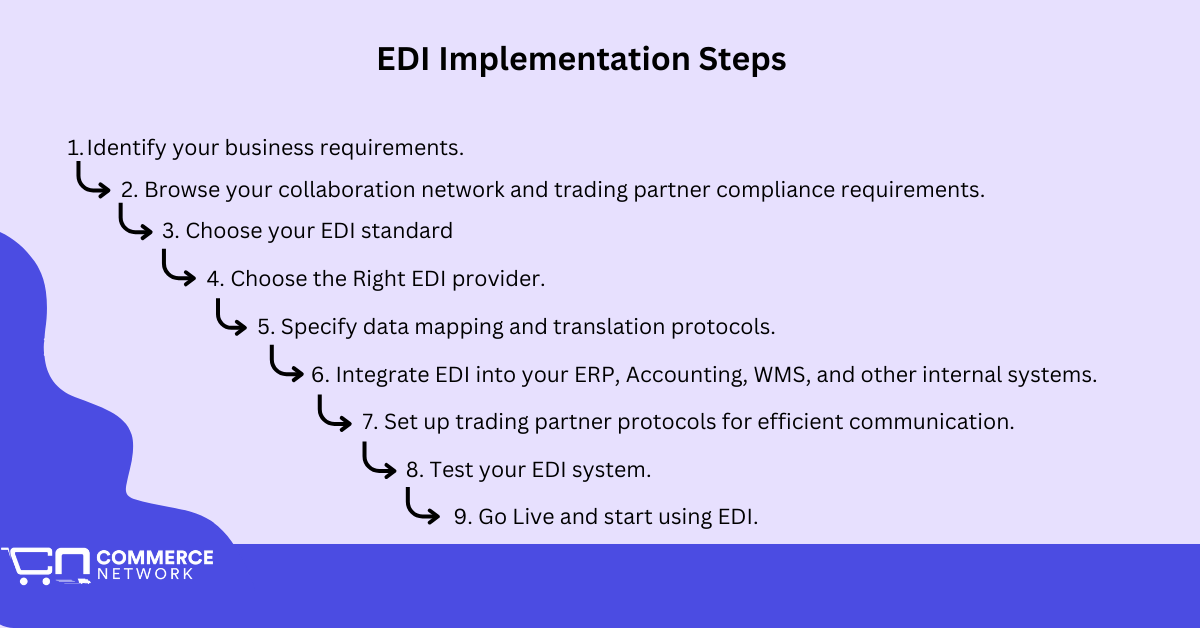
The first step is to identify your business scope.
- What industry is your business in?
- What kinds of products/services do you sell?
- Do you consider yourself a large or a small-scale business?
- Who are your trading partners?
- Does your business need EDI?
- How many resources can you pour into implementing an EDI system?
Have answers ready for these questions and thoroughly identify your business mechanism before starting.
Explore the types of EDI your trading partners are using in their systems. Make sure that your business interests are aligned with your trading partner’s EDI framework.
For example, if your trading partner mostly deals with healthcare and you deal with retail, it may cause conflict when passing EDI documents between each other.
This can be avoided with a full audit of trading partner requirements and compliance standards.
After a full analysis of your and your trading partner’s requirements, choose your EDI standard. This will include the type of EDI documents you need to exchange, while also making sure that the document standard is scalable in the future.
EDI providers are dime-a-dozen. Choosing the right provider means the difference between smooth operations and constant headaches.
Make sure you choose an EDI provider that understands your business and can help you improve your supply chain instead of bogging down your operations.
This step involves specifying the mapping and translation procedures of your documents. It ensures that your business documents are mapped and translated in a way that your other business systems can read them afterward.
After getting the EDI solution, integrate it into your business systems for smooth processing and management of information exchange.
Communicate with your trading partners so that your EDI documents can be exchanged efficiently with your trading partners. Make sure that all the trading partners on your supply chain network are familiar with your EDI solution.
Perform a series of tests by sending a series of sample EDI documents to your collaborative network of trading partners. Identify and resolve any errors that occur during the process.
This may take some time and resources. But validation of your EDI system before a transaction is a necessary step nonetheless.
The final step is to go live and start your EDI transactions. With verifications, compliance, mapping, and integrations out of the way, it is finally time to use EDI for your business.
Simply implementing EDI is not the end of the road. You need to constantly monitor your EDI system, handle any errors that crop up, make sure that your staff is trained for all sorts of EDI-related problems, and more.
Maintaining EDI service is also a massive undertaking that requires constant effort, monitoring, and training. This is especially the case if you need to eventually scale your solution to meet the needs of your supply chain requirements.
With Commerce Network’s end-to-end cloud solution, you do not need to worry about implementing EDI whether you are a large enterprise or a small-scale business.
Our solution is compliant with all major suppliers across different industries like healthcare, retail, office equipment, janitorial supplies, industrial products, and more.
We employ popular EDI standards like X12 and also handle data mapping and translation so you can translate a fully mapped EDI document and use it for communications.
Our comprehensive solution further ensures a smooth supply chain through business integrations with ERP (NetSuite), and Accounting (QuickBooks) systems.
You get a full-fledged EDI service with mapping, translation, transmission, Value Added Network (VAN), as well as error resolution and handling processes with Commerce Network.
Improve Your B2B, B2G, and B2C Ecommerce?
Integrate EDI For Efficiency, Compliance, and Scalability?
Just Curious About EDI?
Give Us A Call
202-280-7060